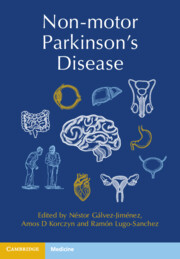Book contents
- Non-Motor Parkinson’s Disease
- Non-Motor Parkinson’s Disease
- Copyright page
- Contents
- Contributors
- Introduction
- Chapter 1 Parkinson’s Disease: An Overview of the Non-Motor Symptomatology
- Chapter 2 Evaluation of the Patient with Parkinson’s Disease in the Early Stages: Non-Motor Phase
- Chapter 3 Non-Motor Symptoms in Late-Stage Parkinson’s Disease
- Chapter 4 Neuropathology of Non-Motor Parkinson’s Disease Symptoms
- Chapter 5 Neuroimaging Studies in Non-Motor Parkinson’s Disease Symptoms
- Chapter 6 Mild Cognitive Impairment
- Chapter 7 Cognitive Dysfunction in Parkinson’s Disease
- Chapter 8 Neuropsychiatric (Behavioral) Symptoms in Parkinson’s Disease
- Chapter 9 Mood Disorders in Parkinson’s Disease
- Chapter 10 Olfactory Dysfunction in Parkinson’s Disease and Related Disorders
- Chapter 11 Oculomotor and Visual-Vestibular Disturbances in Parkinson’s Disease
- Chapter 12 Autonomic Dysfunction and Failure in Parkinson’s Disease
- Chapter 13 Gastrointestinal Disturbances in Parkinson’s Disease Including the Management of Sialorrhea
- Chapter 14 Sexual Dysfunction in Parkinson’s Disease
- Chapter 15 Sleep Disturbances in Parkinson’s Disease
- Chapter 16 Musculoskeletal Disorders and Pain in Parkinson’s Disease
- Chapter 17 Cutaneous Manifestations of Parkinson’s Disease
- Chapter 18 Genetics of Non-Motor Symptoms of Parkinson’s Disease
- Chapter 19 Drug-Induced Non-Motor Symptoms in Parkinson’s Disease
- Chapter 20 Impulse Control Disorders and the Dopamine Dysregulation Syndrome
- Chapter 21 Serotonin Syndrome and Drug Interactions, Hypertensive Complications, and, Adverse Effects of Monoamine Oxidase Inhibitors in Patients with Parkinson’s Disease
- Chapter 22 Parkinson’s Disease and Pregnancy
- Index
- Plate Section (PDF Only)
- References
Chapter 22 - Parkinson’s Disease and Pregnancy
Published online by Cambridge University Press: 05 March 2022
- Non-Motor Parkinson’s Disease
- Non-Motor Parkinson’s Disease
- Copyright page
- Contents
- Contributors
- Introduction
- Chapter 1 Parkinson’s Disease: An Overview of the Non-Motor Symptomatology
- Chapter 2 Evaluation of the Patient with Parkinson’s Disease in the Early Stages: Non-Motor Phase
- Chapter 3 Non-Motor Symptoms in Late-Stage Parkinson’s Disease
- Chapter 4 Neuropathology of Non-Motor Parkinson’s Disease Symptoms
- Chapter 5 Neuroimaging Studies in Non-Motor Parkinson’s Disease Symptoms
- Chapter 6 Mild Cognitive Impairment
- Chapter 7 Cognitive Dysfunction in Parkinson’s Disease
- Chapter 8 Neuropsychiatric (Behavioral) Symptoms in Parkinson’s Disease
- Chapter 9 Mood Disorders in Parkinson’s Disease
- Chapter 10 Olfactory Dysfunction in Parkinson’s Disease and Related Disorders
- Chapter 11 Oculomotor and Visual-Vestibular Disturbances in Parkinson’s Disease
- Chapter 12 Autonomic Dysfunction and Failure in Parkinson’s Disease
- Chapter 13 Gastrointestinal Disturbances in Parkinson’s Disease Including the Management of Sialorrhea
- Chapter 14 Sexual Dysfunction in Parkinson’s Disease
- Chapter 15 Sleep Disturbances in Parkinson’s Disease
- Chapter 16 Musculoskeletal Disorders and Pain in Parkinson’s Disease
- Chapter 17 Cutaneous Manifestations of Parkinson’s Disease
- Chapter 18 Genetics of Non-Motor Symptoms of Parkinson’s Disease
- Chapter 19 Drug-Induced Non-Motor Symptoms in Parkinson’s Disease
- Chapter 20 Impulse Control Disorders and the Dopamine Dysregulation Syndrome
- Chapter 21 Serotonin Syndrome and Drug Interactions, Hypertensive Complications, and, Adverse Effects of Monoamine Oxidase Inhibitors in Patients with Parkinson’s Disease
- Chapter 22 Parkinson’s Disease and Pregnancy
- Index
- Plate Section (PDF Only)
- References
Summary
Parkinson’s disease (PD) in pregnancy is a rare occurrence. PD presents before the age of 40 in only 5% of cases and less than 400 women less than 50 years of age are diagnosed with PD each year in the United States [1]. However, as the average maternal age is increasing, it may become more common. Incidence of pregnancy in PD is unknown and knowledge is limited to case reports.
Animal models suggest estrogen has a neuroprotective effect on dopaminergic neurons by influencing anti-oxidative, anti-inflammatory, and anti-apoptotic pathways with studies showing cell death can be significantly decreased by administration of estrogen [2]. Other animal studies showed estrogen has dopaminergic effect by inhibiting catechol-O-methyltransferase (COMT) and striatal dopamine transporter activity as well as enhancing tyrosine hydroxylase [3, 4]. Incidence of PD is less in women, yet after menopause risk of PD increases [5]. Women tend to have less severe disease but more dyskinesia [6, 7].
- Type
- Chapter
- Information
- Non-motor Parkinson's Disease , pp. 252 - 254Publisher: Cambridge University PressPrint publication year: 2022



